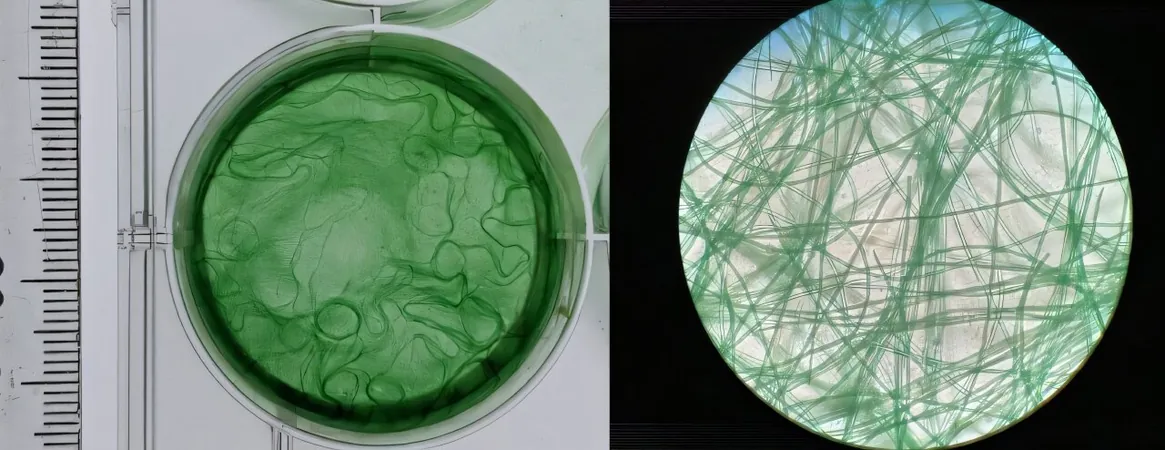
Scientists Crack the Code of Ancient Bacteria's Living Mats—Transforming Our Understanding of Nature!
2025-01-08
Author: Siti
Cyanobacteria: Nature’s Early Superheroes
Dating back over two billion years, cyanobacteria are considered the Earth's first life forms adept at photosynthesis. These tiny microorganisms played a pivotal role in creating an oxygen-rich atmosphere, setting the stage for complex life. Presently, they thrive in a multitude of aquatic environments, from ocean depths to frostbitten Antarctic lakes. Dr. Marco Mazza, a specialist in non-equilibrium physics, emphasizes their importance: “Cyanobacteria are everywhere—in seas, lakes, and rivers—and they are fundamental to our food chain and oxygen supply.”
The Enigma of Biomats Unveiled
Despite being micrometers in size (approximately 1 to 30 µm), cyanobacteria can assemble into visible colonies known as "biomats." Often mistaken as mere blue-green algae, these mats can resemble slippery green slime found in stagnant waters, riverbeds, and shorelines. Biomats emerge when these microorganisms intertwine to fashion thread-like structures. A single biomat, comparable to an A4 sheet, can form within mere hours and may contain hundreds of millions of individual cyanobacteria. When nutrient levels in freshwater systems rise, it results in excessive growth, leading to what is commonly seen as harmful algal blooms. But why do they weave together? The answer lies in survival; biomats provide stability and protection, allowing the colony to adapt to varying water flows, light levels, and nutrient availability. “Essentially, cyanobacteria invented weaving long before humans did,” Dr. Mazza poignantly notes, suggesting the potential inspiration for dynamic materials responsive to environmental changes.
Decoding the Secret of Biomats
Using state-of-the-art microscopy, simulations, and theoretical models, the research team explored how these filamentous bacteria arrange themselves. Their experiments focused on a particular species, Oscillatoria lutea, capturing intricate interactions among filaments as they self-organized under different conditions. Their findings reveal that the formation of these complex patterns can be explained by simple rules related to filament density and motility. A higher density and movement of filaments lead to more stable biomat formations, while filament length also influences how organized the structures ultimately become.
Why This Research Matters
The significance of this research extends beyond mere academic interest. Professor Lucas Goehring highlighted its potential applications: “By understanding the behaviors that drive biomat formation, we can not only better understand ancient multicellular life but also its contemporary implications in stabilizing sediments and preventing problematic biofilms on marine vessels.” Dr. Jan Cammann adds that continued exploration into these biological processes could lead to advancements in how we comprehend bacterial biofilms—integral to matters ranging from environmental health to medical challenges. As scientists continue to delve into the amazing world of cyanobacteria, the potential to learn from nature's designs could revolutionize numerous fields—ultimately showing us that sometimes the best solutions lie within the very ecosystems we often overlook. Will future developments lead to revolutionary materials inspired by these ancient microorganisms? Keep an eye out for the continuing evolution of this research!
 Brasil (PT)
Brasil (PT)
 Canada (EN)
Canada (EN)
 Chile (ES)
Chile (ES)
 Česko (CS)
Česko (CS)
 대한민국 (KO)
대한민국 (KO)
 España (ES)
España (ES)
 France (FR)
France (FR)
 Hong Kong (EN)
Hong Kong (EN)
 Italia (IT)
Italia (IT)
 日本 (JA)
日本 (JA)
 Magyarország (HU)
Magyarország (HU)
 Norge (NO)
Norge (NO)
 Polska (PL)
Polska (PL)
 Schweiz (DE)
Schweiz (DE)
 Singapore (EN)
Singapore (EN)
 Sverige (SV)
Sverige (SV)
 Suomi (FI)
Suomi (FI)
 Türkiye (TR)
Türkiye (TR)
 الإمارات العربية المتحدة (AR)
الإمارات العربية المتحدة (AR)